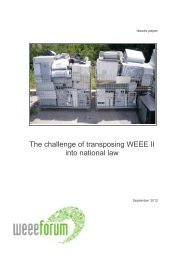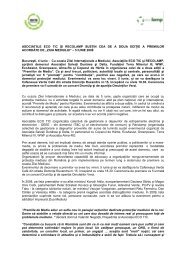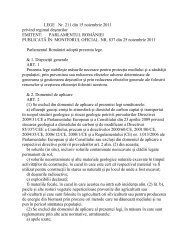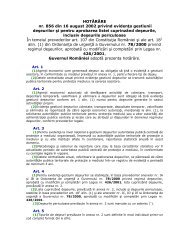PCB's in Small Capacitors from Waste Electrical and ... - Ecotic
PCB's in Small Capacitors from Waste Electrical and ... - Ecotic
PCB's in Small Capacitors from Waste Electrical and ... - Ecotic
You also want an ePaper? Increase the reach of your titles
YUMPU automatically turns print PDFs into web optimized ePapers that Google loves.
PCB’s <strong>in</strong> <strong>Small</strong> <strong>Capacitors</strong> <strong>from</strong> <strong>Waste</strong> <strong>Electrical</strong> <strong>and</strong> Electronic Equipments<br />
Annex A: Summarized Results of the Analyses 2005 by Technical Control Bodies of<br />
SENS <strong>and</strong> SWICO<br />
In 2005, the technical control bodies of SENS <strong>and</strong> SWI-<br />
CO studied the case of polychlor<strong>in</strong>ated biphenyls<br />
(PCB’s) <strong>in</strong> small capacitors. The study focussed on the<br />
sampl<strong>in</strong>g of eight vary<strong>in</strong>g types of small capacitors <strong>from</strong><br />
electrical <strong>and</strong> electronic equipments, their preparation<br />
<strong>and</strong> analysis of PCB’s <strong>and</strong> total chlor<strong>in</strong>e concentration.<br />
Additionally, the composition of three capacitors <strong>from</strong><br />
un<strong>in</strong>terruptible power supply systems (UPS) was exam<strong>in</strong>ed<br />
by Empa St. Gall.<br />
By means of a gas chromatograph with electron capture<br />
detector (ECD), the PCB’s were determ<strong>in</strong>ed, accord<strong>in</strong>g<br />
to DIN 51’527, <strong>and</strong> rated by projection bas<strong>in</strong>g on factor<br />
5 follow<strong>in</strong>g LAGA. The total chlor<strong>in</strong>e content was appraised<br />
accord<strong>in</strong>g to DIN EN ISO 10’304.<br />
It appears <strong>from</strong> the analyses that the PCB content of<br />
capacitors <strong>from</strong> pr<strong>in</strong>ted wir<strong>in</strong>g boards, power supply<br />
units, un<strong>in</strong>terruptible power supply systems, small<br />
household appliances (SHA) <strong>and</strong> lamps was situated<br />
under the detection limit (< 5 mg/kg) or approximat<strong>in</strong>g,<br />
for electrolyte capacitors, 6 mg/kg. <strong>Capacitors</strong> <strong>from</strong> large<br />
household appliances (LHA) reached a PCB content<br />
of 3’623 mg/kg.<br />
By determ<strong>in</strong><strong>in</strong>g the total chlor<strong>in</strong>e content, the chlor<strong>in</strong>e <strong>in</strong><br />
PVC was taken <strong>in</strong>to account. Consequently, the results<br />
are undifferentiated <strong>and</strong> cannot be used for further <strong>in</strong>terpretations.<br />
The analyses performed by Empa St. Gall on the composition<br />
of three capacitors <strong>from</strong> un<strong>in</strong>terruptible power<br />
supply systems (see Table 12) did not reveal the presence<br />
of particularly toxic matters. As dielectrics <strong>in</strong> paper<br />
capacitors which, previously to 1984, often consisted of<br />
PCB’s, the follow<strong>in</strong>g substitutes could be identifi ed:<br />
<strong>Capacitors</strong> A: glycol derivate, totally absorbed by paper<br />
<strong>Capacitors</strong> B: l ow volatile m<strong>in</strong>eral oil, consistence resembl<strong>in</strong>g<br />
petroleum jelly<br />
<strong>Capacitors</strong> C: d ioctyl phtalate, diphenyl ethane <strong>and</strong> dimethyl<br />
diphenyl, th<strong>in</strong> fl uid consistence<br />
Table 11 PCB <strong>and</strong> total chlor<strong>in</strong>e content of diverse capacitor types <strong>from</strong> waste electrical <strong>and</strong><br />
electronic equipment<br />
Device Categories / Components Amount Weight [ g ] PCB’s [ mg/kg ] Total Chlor<strong>in</strong>e [ % ]<br />
Pr<strong>in</strong>ted wir<strong>in</strong>g boards, mid-size 200 2’580 < 5 1.20<br />
Pr<strong>in</strong>ted wir<strong>in</strong>g boards, large 50 3’340 < 5 0.36<br />
Power supply, small 400 2’040 < 5 0.68<br />
Power supply, mid-size – large 40 760 < 5 0.51<br />
UPS, mixed 50 600 < 5 0.92<br />
Large electrical equipments 35 4’270 3’623 0.81<br />
Elektrolyte capacitors 24 2’950 6 0.38<br />
<strong>Small</strong> household appliances<br />
<strong>and</strong> lamps<br />
25 2’709,5 < 5 0.10<br />
Table 12 Composition of three capacitors <strong>from</strong> un<strong>in</strong>terruptuble power supply systems (Empa St. Gallen, 2005)<br />
Text <strong>Capacitors</strong> A <strong>Capacitors</strong> B <strong>Capacitors</strong> C<br />
Total weight, g 750 344 139<br />
Alum<strong>in</strong>ium cas<strong>in</strong>g, weight <strong>in</strong> g 110 60 41<br />
Alum<strong>in</strong>ium cas<strong>in</strong>g, share <strong>in</strong> % 15 17 29<br />
Alum<strong>in</strong>ium sheet, weight <strong>in</strong> g 330 105 31<br />
Alum<strong>in</strong>ium sheet, share <strong>in</strong> % 44 31 22<br />
Plastic material etc., weight <strong>in</strong> g 320 140 40<br />
Plastic material etc., share <strong>in</strong> % 43 41 29<br />
Oil etc., weight <strong>in</strong> g 0 35 30<br />
Oil etc., share <strong>in</strong> % 0 10 22<br />
20









